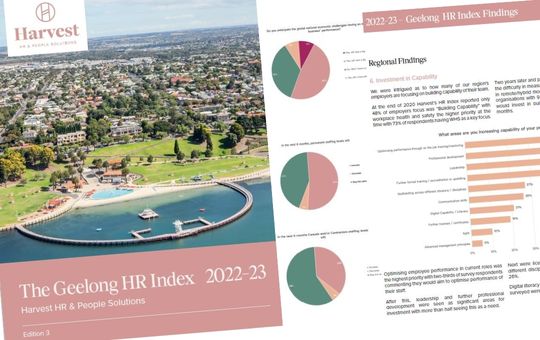How is the economy and inflationary pressures impacting the Geelong region’s employers?
The Geelong HR Index survey canvassed over 100 of the region’s employers, across 11 industry sectors and comprises findings from a host of our region’s employers. We sincerely thank all the organisations whose contribution has assisted in developing the picture for the region.
A complimentary abridged Regional Findings 2022 – 2023 can be accessed here.
To purchase the detailed report with industry specific knowledge please email: [email protected] or t: 1300 363 128
Limited edition Hard Copy $165
Electronic .pdf $110
The Geelong HR Index 2022
104 Employers Surveyed:
• 18 MICRO (less than 5 employees)
• 50 SMALL (5 – 100 employees)
• 28 MEDIUM (100 – 500 employees)
• 12 LARGE (greater than 500 employees)
11 Industry Sectors:
1. Agriculture and Food
2. Education
3. Energy & Resources
4. Engineering & Manufacturing
5. Government & Public Sector
6. Health
7. Membership Bodies & Not for Profit
8. Professional Services
9. Property, Construction and Real Estate
10. Sport, Leisure and Hospitality
11. Wholesale, Warehouse and Transport
In 2022 the catalyst for Harvest conducting the HR Index Survey was a change to the economic landscape. We were keen to see how the economy and inflationary pressures were impacting our region’s employers. This year our questions centred on three key areas; first the economy and its impact; second employment trends and third HR trends which honed in on capability, talent attraction, acquisition and retention, hybrid/blended work models today and whether companies are changing the office to accommodate new ways of working.
The economy is creating concern for businesses in the region with over half of respondents feeling the changes to the economic landscape would have a slight (48%) to significant (9%) impact on their business, with micro business feeling the least confident of their future – often as these comprise those that are self-employed and any affect that is impacting consumers will impact
these business owners.
Notwithstanding this, when it comes to people most of our region’s employers will be hiring and if not strongly hiring in the coming six months felt their staffing levels would remain steady. Our growth sectors include
• Agriculture and Food
• Sport, Leisure and Hospitality
• Property, Construction and Real Estate
• Engineering and Manufacturing
• Wholesale, Warehouse and Transport
• Health
• Government and Public Sector
All of whom the majority reported increased staffing levels.
The biggest need was for blue collar workers with growing demand for staff coming from our key employers who employ trade, semi and unskilled labour. Agriculture, food, engineering, manufacturing and construction sectors also recorded needing technical specialists and engineers. Health is as strong as it was three years ago, continuing to employ clinical specialists and nurses. For the Community Sector employers (who have received funding) there is significant increases in numbers of community and social workers but this was not balanced across all community service organisations. Our large public sector and government employers reported on average employing over 50 miscellaneous workers – too vast to list the disciplines across the organisation.
As we head into the holidays, employers of leisure and hospitality workers report a dramatic increase in hospitality workers and our need for executive assistants and administrative staff has increased also.
When queried if employers are investing in building capability in the coming 12 months, 92% answered yes. There is a significant desire to boost skills with the top priority being optimising performance of employees in their current roles, followed by leadership, professional development or further training and upskilling. This is partiy due to many organisations L&D agenda being
paused with pressing priorities amidst the pandemic, recognising the need to boost productivity and an understanding that underperforming staff cannot simply be replaced so the best strategy is to work to improve their abilities in the workplace.
The vast majority of our employers were keen to support a region-wide Talent Attraction Strategy. The gaps, according to our employers were strongly around, accommodation, transport and connecting outlying regions (Surf Coast, the Bellarine and Golden Plains) more seamlessly with central Geelong.
Additionally, employers would support a talent attraction strategy that promotes and showcases the region for its lifestyle, beaches, natural environment, commutability to Melbourne, its growth as a city (without the challenge of a bigger city), our schools and employment opportunities.
Talent acquisition challenges are being felt across the region with many employers stating the lack of supply as the key recruitment challenge followed by an inability to compete on an individual’s growing salary expectations or the benefits that larger employers can offer.
The biggest reason employers gave for employees moving is for career progression. With over two-thirds of respondents employing up to 100 staff, to commenting they cannot compete with larger organisations on career progression. Headhunting and cannibalism are now a common strategy with over one-quarter commenting there was cannibalism within their sector. This was particularly true for Energy and Resources as well as Property Construction and Real Estate. Many companies also found their employees were leaving for greater salary and benefits packages, a result of economic pressures having employees re-think their value with their employer.
The hybrid/blended model for workers that don’t need to be at site continues to be a topic of debate. At the peak of the pandemic, employers were highly in favour of blended work arrangements but now many are seeking a return to site or the hybrid three days at office and two from home. Employers are becoming more fixed on their preference of their employees. Bigger companies seem
to entertain the prospect of teams determining their best working model or a model that considers the work to be done to inform the work location for employees. There still appears to be a divide on this topic between the employer and employee.
As we cast our eyes across the globe to inform the workspace of the future, we find that Geelong’s organisations are not undertaking significant office design changes that reflect organisational design. The majority of employers said they would not be making any changes to their office due to changes in the way employees work. The large employers were those that were putting greater emphasis on changing office fit out/layout as they have a greater number of staff who continue to work in a hybrid manner.
Other trends being addressed by employers today is how to manage sick workers amidst home working, where employees are still working (because they can) when they are sick. From home they continue working even at lower productivity levels than when well. Added to this, sick leave that was once taken is now accruing. This challenge is causing consideration to overhauling sick leave policies for those on flexible working arrangements.
Another trend starting to come into play is the 4-day week, 9-day fortnight and 19-day month, where workers compress their time.
Also, and not going away, many employers have not seen the end to mental health challenges in the workplace. The everlasting impact the pandemic has had on an individual’s mental health cannot be discounted nor dismissed.
Findings from the 2022 – 2023 Geelong HR Index were discussed at a business breakfast on Wednesday 5 October, 2022.

